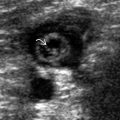KEY FACTS
Terminology
- •
Benign prostatic hyperplasia (BPH)
- ○
Term reserved for histopathologic pattern of smooth muscle and epithelial cell proliferation
- ○
Hyperplasia correct term since BPH is characterized by increased number of epithelial stromal cells in periurethral area of prostate (not hypertrophy, which means increase in size)
- ○
Imaging
- •
Sonographic appearance of BPH variable, depending on histopathologic changes
- •
Ultrasound cannot reliably differentiate BPH from prostate cancer
- •
Ultrasound may be used to measure prostate size and PVR as well as evaluate for upper tract obstruction in men with BPH and renal insufficiency
- •
Estimated prostate volume: Prolate ellipsoid formula: Width x height x length x π/6 = W x H x L x 0.52
Top Differential Diagnoses
- •
Prostate, bladder carcinoma
- •
Prostatitis
Pathology
- •
Bladder outlet obstruction from BPH may occur from urethral constriction from increased smooth muscle tone and resistance (dynamic component) &/or urethral compression from gland enlargement (static component)
- •
Possible bladder sequelae: Trabeculation, diverticula, calculi, detrusor muscle failure
- •
Possible upper tract changes: Ureterectasis, hydronephrosis
- ○
Can be from 2° vesicoureteral reflux, obstruction from muscular hypertrophy or angulation at ureterovesical junction, sustained high-pressure bladder storage
- ○
Scanning Tips
- •
Avoid including seminal vesicles in transabdominal prostate measurements
 ) surrounding the urethra. Central zone is in orange, peripheral zone is in green, and anterior fibromuscular stroma is in yellow.
) surrounding the urethra. Central zone is in orange, peripheral zone is in green, and anterior fibromuscular stroma is in yellow.

 and elevation of the bladder base
and elevation of the bladder base  . Nodular protrusion into the bladder (a.k.a. enlarged “median lobe”) can ball-valve into the urethra and cause severe obstructive symptoms.
. Nodular protrusion into the bladder (a.k.a. enlarged “median lobe”) can ball-valve into the urethra and cause severe obstructive symptoms.
Stay updated, free articles. Join our Telegram channel

Full access? Get Clinical Tree








